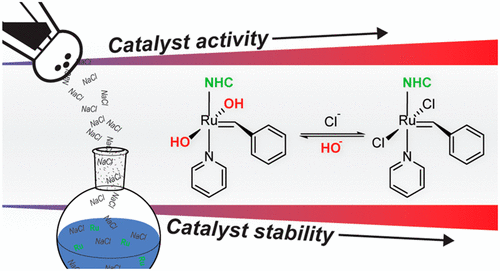当前位置:
X-MOL 学术
›
J. Am. Chem. Soc.
›
论文详情
Our official English website, www.x-mol.net, welcomes your
feedback! (Note: you will need to create a separate account there.)
It’s Better with Salt: Aqueous Ring-Opening Metathesis Polymerization at Neutral pH
Journal of the American Chemical Society ( IF 14.4 ) Pub Date : 2020-07-16 , DOI: 10.1021/jacs.0c05499 Jeffrey C Foster 1 , Marcus C Grocott 1 , Lucy A Arkinstall 1 , Spyridon Varlas 1 , McKenna J Redding 2 , Scott M Grayson 2 , Rachel K O'Reilly 1
Journal of the American Chemical Society ( IF 14.4 ) Pub Date : 2020-07-16 , DOI: 10.1021/jacs.0c05499 Jeffrey C Foster 1 , Marcus C Grocott 1 , Lucy A Arkinstall 1 , Spyridon Varlas 1 , McKenna J Redding 2 , Scott M Grayson 2 , Rachel K O'Reilly 1
Affiliation

|
Aqueous ring-opening metathesis polymerization (ROMP) is a powerful tool for polymer synthesis under environmentally friendly conditions, functionalization of biomacromolecules, and preparation of polymeric nanoparticles via ROMP-induced self-assembly (ROMPISA). Although new water-soluble Ru-based metathesis catalysts have been developed and evaluated for their efficiency in mediating cross metathesis (CM) and ring-closing metathesis (RCM) reactions, little is known with regards to their catalytic activity and stability during aqueous ROMP. Here, we investigate the influence of solution pH, the presence of salt additives, and catalyst loading on ROMP monomer conversion and catalyst lifetime. We find that ROMP in aqueous media is particularly sensitive to chloride ion concentration and propose that this sensitivity originates from chloride ligand displacement by hydroxide or H2O at the Ru center, which reversibly generates an unstable and metathesis inactive complex. The formation of this Ru-(OH)n complex not only reduces monomer conversion and catalyst lifetime but also influences polymer microstructure. However, we find that the addition of chloride salts dramatically improves ROMP conversion and control. By carrying out aqueous ROMP in the presence of various chloride sources such as NaCl, KCl, or tetrabutylammonium chloride, we show that diblock copolymers can be readily synthesized via ROMPISA in solutions with high concentrations of neutral H2O (i.e., 90 v/v%) and relatively low concentrations of catalyst (i.e., 1 mol %). The capability to conduct aqueous ROMP at neutral pH is anticipated to enable new research avenues, particularly for applications in biological media, where the unique characteristics of ROMP provide distinct advantages over other polymerization strategies.
中文翻译:

加盐效果更好:中性 pH 条件下的水开环复分解聚合
水开环易位聚合(ROMP)是环境友好条件下聚合物合成、生物大分子功能化以及通过ROMP诱导自组装(ROMPISA)制备聚合物纳米粒子的有力工具。尽管新型水溶性钌基复分解催化剂已被开发出来,并对其介导交叉复分解(CM)和闭环复分解(RCM)反应的效率进行了评估,但对其在水性ROMP过程中的催化活性和稳定性知之甚少。在这里,我们研究了溶液 pH 值、盐添加剂的存在以及催化剂负载量对 ROMP 单体转化率和催化剂寿命的影响。我们发现水介质中的 ROMP 对氯离子浓度特别敏感,并提出这种敏感性源于 Ru 中心处的氯配体被氢氧化物或 H2O 取代,这可逆地产生不稳定且复分解无活性的复合物。这种 Ru-(OH)n 络合物的形成不仅会降低单体转化率和催化剂寿命,还会影响聚合物的微观结构。然而,我们发现氯化物盐的添加显着改善了 ROMP 转化和控制。通过在各种氯化物源(例如 NaCl、KCl 或四丁基氯化铵)存在下进行水性 ROMP,我们表明可以在高浓度中性 H2O(即 90 v/v%)的溶液中通过 ROMPISA 轻松合成二嵌段共聚物和相对低浓度的催化剂(即1 mol%)。 在中性 pH 值下进行水性 ROMP 的能力预计将开辟新的研究途径,特别是在生物介质中的应用,其中 ROMP 的独特特性提供了优于其他聚合策略的独特优势。
更新日期:2020-07-16
中文翻译:

加盐效果更好:中性 pH 条件下的水开环复分解聚合
水开环易位聚合(ROMP)是环境友好条件下聚合物合成、生物大分子功能化以及通过ROMP诱导自组装(ROMPISA)制备聚合物纳米粒子的有力工具。尽管新型水溶性钌基复分解催化剂已被开发出来,并对其介导交叉复分解(CM)和闭环复分解(RCM)反应的效率进行了评估,但对其在水性ROMP过程中的催化活性和稳定性知之甚少。在这里,我们研究了溶液 pH 值、盐添加剂的存在以及催化剂负载量对 ROMP 单体转化率和催化剂寿命的影响。我们发现水介质中的 ROMP 对氯离子浓度特别敏感,并提出这种敏感性源于 Ru 中心处的氯配体被氢氧化物或 H2O 取代,这可逆地产生不稳定且复分解无活性的复合物。这种 Ru-(OH)n 络合物的形成不仅会降低单体转化率和催化剂寿命,还会影响聚合物的微观结构。然而,我们发现氯化物盐的添加显着改善了 ROMP 转化和控制。通过在各种氯化物源(例如 NaCl、KCl 或四丁基氯化铵)存在下进行水性 ROMP,我们表明可以在高浓度中性 H2O(即 90 v/v%)的溶液中通过 ROMPISA 轻松合成二嵌段共聚物和相对低浓度的催化剂(即1 mol%)。 在中性 pH 值下进行水性 ROMP 的能力预计将开辟新的研究途径,特别是在生物介质中的应用,其中 ROMP 的独特特性提供了优于其他聚合策略的独特优势。











































 京公网安备 11010802027423号
京公网安备 11010802027423号